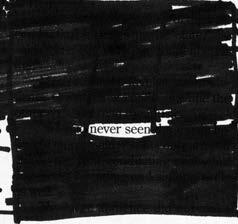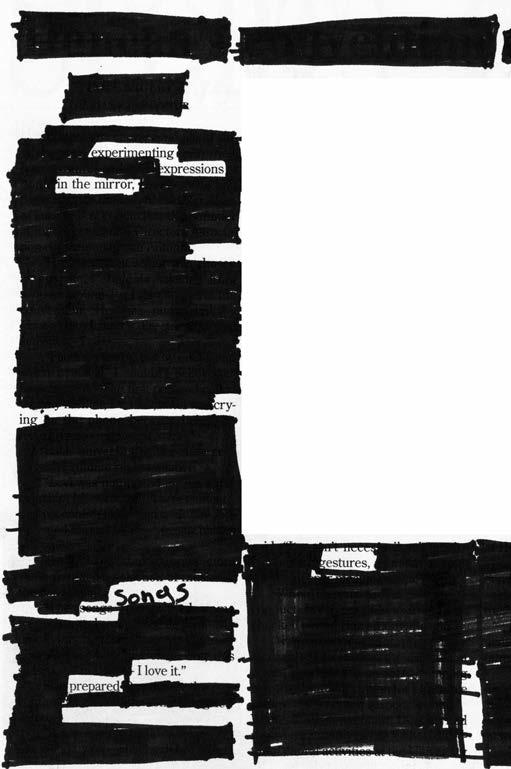
4 minute read
Blackout Poetry
DISCOVERINGTHEARTOFREDACTINGEVERYDAYWORDS
Story by POETRYISDIFFICULTFOR most peo-
Advertisement
Andy ple. Whether it is struggling for a rhyme, or just worrying if that Coughlan deep, personal meaning is either obscure or too obvious, it is an art form that people tend to avoid. But what if there was a simple and effective way to “write” poetry without ever having to come up with just the right word? In fact, the only thing to consider is which words to discard.
Welcome to blackout poetry.
The Writing Center at Lamar University hosted a Blackout Poetry Workshop, April 4.
“April is probably one of the most literary months,” Jennifer Ravey, Writing Center director, said. “The week of April 17 is National Library Appreciation Week and April 23 is World Book Night.”
Ravey said that when she was asked to organize an event to commemorate the month, she wanted to do something other than a reading.
“I wanted to do something more interactive,” she said, “something we can actually do as a group.”
Blackout poetry consists of taking a marker to a printed page — a newspaper, magazine or an old book — and redacting, or crossing out, some words on the page. What is left is the poem.
“The great thing about blackout poetry is that you don’t have to know how to spell, you don’t have to know how to write,” Ravey said.
“The restriction frees you. You are bound by the words on the page, but it also gives you the freedom not to have to think of them yourself. It’s just creative, innovative and fun. There were a lot of people laughing (during the workshop).”
Part of the fun of creating a blackout poem is manipulating the available words, often at the expense of “normal” syntax.
“(I was) asked, ‘What do you do about punctuation?’” Ravey said. “Well, you either put it in yourself, or you don’t have it. It gives the poem multiple ways to be read. For example, mine doesn’t have any punctuation. I know where the line break is, but the fact that there is no line break gives a freedom to the reader.”
Blackout poetry certainly has its roots in the calligrams and cut up poems of the Dada and Surrealist movements, but writer Austin Kleon is the man credited with the recent popularity of the form. In 2010,


Kleon published “Newspaper Blackout,” a collection of poetry created by redacting articles in the New York Times.
“It’s actually a lecture he toured all over the country and his publisher asked him to write a book,” Ravey said, adding that she came across it about five years ago when a student did a blackout poem for a class project.
“I thought it was fascinating,” she said. “What Austin Kleon does, people will send in their poems and he publishes them on his blog.”
While some people choose to neatly black out the words, other scribble or draw lines from one word to another. There are no rules as to how it “should” be done.
As Ravey thumbed through the examples from the workshop, she said she loved the variety of techniques. She referred back to a blackout poem she had seen before.
“What I like is that someone created a map out of theirs, so it became not just the words, but also the image,” she said. “It’s like e.e.cummings — the structure is part of the meaning.”
Ravey said that some of her favorite art incorporates words with the images.
“Poetry that incorporates the visual is a whole other level,” she said. “I love a photograph that there’s one word, and it might be completely obscured, but you see it and it informs your opinion of the photograph.”
“When I teach poetry, students have hang ups about it, they just do,” she said. “So one of the things I say is, ‘What do you not like about poetry?’ So they say, ‘I don’t know what it means, I don’t understand it.’ Well then, pick me out the words in this poem, the words that stand out to you. They do and I ask them, ‘Why did that word stand out to you? What is it about that word? Is it the meaning that you derive from it? Is it the order?’ Once they look at it that way, sometimes if you change the perspective and have them pick out those images — those feelings — it completely changes it for them.”
Ravey said that people tend to go through phases when they are young when they write poetry.
“You go through this phase where you are young and hormonal and you get all that out on paper,” she said. “Then suddenly it’s an embarrassment. And it is personal and that becomes harder for people.”
Blackout poetry, with its restrictions, allows people to be free to compose poems in a fun way without the worry of being judged.
So for any budding poets out there, grab yourself a Sharpie and go for it. You can even use this article.
For more information, visit austinkleon.com. For more blackout poems, see Thoughtcrime, page 13.





Brook Gipson, left, and Adam Haskett, right, wrote their blackout poems from the same article with very different results.

Poem by Daniel Vallee





